Botanical garden
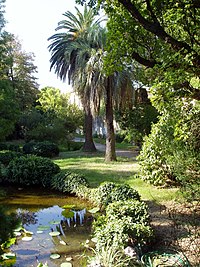
A botanical garden or botanic garden
Most are at least partly open to the public, and may offer guided tours, public programming such as workshops, courses, educational displays, art exhibitions, book rooms, open-air theatrical and musical performances, and other entertainment.

Botanical gardens are often run by universities or other scientific research organizations, and often have associated
Many botanical gardens offer diploma/certificate programs in horticulture, botany and taxonomy. There are many internship opportunities offered to aspiring horticulturists. As well as opportunities for students/researchers to use the collection for their studies.
History
The origin of modern botanical gardens is generally traced to the appointment of botany professors to the medical faculties of universities in 16th-century Renaissance Italy, which also entailed curating a medicinal garden. However, the objectives, content, and audience of today's botanic gardens more closely resembles that of the grandiose gardens of antiquity and the educational garden of Theophrastus in the Lyceum of ancient Athens.[2]
The early concern with medicinal plants changed in the 17th century to an interest in the new plant imports from explorations outside Europe as botany gradually established its independence from medicine. In the 18th century, systems of nomenclature and classification were devised by botanists working in the herbaria and universities associated with the gardens, these systems often being displayed in the gardens as educational "order
With the rapid expansion of European colonies around the globe in the late 18th century, botanic gardens were established in the tropics, and economic botany became a focus with the hub at the Royal Botanic Gardens, Kew, near London.

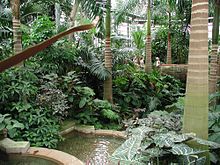
Over the years, botanical gardens, as cultural and scientific organisations, have responded to the interests of botany and
Definitions
The term tends to be used somewhat differently in different parts of the world. For example a large woodland garden with a good collection of rhododendron and other flowering tree and shrub species is very likely to present itself as a "botanical garden" if it is located in the US, but very unlikely to do so if in the UK (unless it also contains other relevant features). Very few of the sites used for the UK's dispersed National Plant Collection, usually holding large collections of a particular taxonomic group, would call themselves "botanic gardens".
This has been further reduced by Botanic Gardens Conservation International to the following definition which "encompasses the spirit of a true botanic garden":[4] "A botanic garden is an institution holding documented collections of living plants for the purposes of scientific research, conservation, display and education."[5] The following definition was produced by staff of the Liberty Hyde Bailey
A botanical garden is a controlled and staffed institution for the maintenance of a living collection of plants under scientific management for purposes of education and research, together with such libraries, herbaria, laboratories, and museums as are essential to its particular undertakings. Each botanical garden naturally develops its own special fields of interests depending on its personnel, location, extent, available funds, and the terms of its charter. It may include greenhouses, test grounds, an herbarium, an arboretum, and other departments. It maintains a scientific as well as a plant-growing staff, and publication is one of its major modes of expression.
This broad outline is then expanded:[6]
The botanic garden may be an independent institution, a governmental operation, or affiliated to a college or university. If a department of an educational institution, it may be related to a teaching program. In any case, it exists for scientific ends and is not to be restricted or diverted by other demands. It is not merely a landscaped or ornamental garden, although it may be artistic, nor is it an experiment station or yet a park with labels on the plants. The essential element is the intention of the enterprise, which is the acquisition and dissemination of botanical knowledge.
A contemporary botanic garden is a strictly protected green area, where a managing organization creates landscaped gardens and holds documented collections of living plants and/or preserved plant accessions containing functional units of heredity of actual or potential value for purposes such as scientific research, education, public display, conservation, sustainable use, tourism and recreational activities, production of marketable plant-based products and services for improvement of human well-being.
The botanical gardens network

Worldwide, there are now about 1800 botanical gardens and arboreta in about 150 countries (mostly in temperate regions) of which about 550 are in Europe (150 of which are in Russia),[7] 200 in North America,[8] and an increasing number in East Asia.[9] These gardens attract about 300 million visitors a year.[10]
Historically, botanical gardens exchanged plants through the publication of seed lists (these were called
The International Association of Botanic Gardens[12] was formed in 1954 as a worldwide organisation affiliated to the International Union of Biological Sciences. More recently, coordination has also been provided by Botanic Gardens Conservation International (BGCI), which has the mission "To mobilise botanic gardens and engage partners in securing plant diversity for the well-being of people and the planet".[13] BGCI has over 700 members – mostly botanic gardens – in 118 countries, and strongly supports the Global Strategy for Plant Conservation by producing a range resources and publications, and by organizing international conferences and conservation programs.
Communication also happens regionally. In the United States, there is the American Public Gardens Association[14] (formerly the American Association of Botanic Gardens and Arboreta), and in Australasia there is the Botanic Gardens of Australia and New Zealand (BGANZ).[15]
History and development
The history of botanical gardens is closely linked to the history of botany itself. The botanical gardens of the 16th and 17th centuries were medicinal gardens, but the idea of a botanical garden changed to encompass displays of the beautiful, strange, new and sometimes economically important plant trophies being returned from the European colonies and other distant lands.[16]
Later, in the 18th century, they became more educational in function, demonstrating the latest plant classification systems devised by botanists working in the associated herbaria as they tried to order these new treasures. Then, in the 19th and 20th centuries, the trend was towards a combination of specialist and eclectic collections demonstrating many aspects of both horticulture and botany.[17]
Precursors
The idea of "scientific" gardens used specifically for the study of plants dates back to antiquity.[18]
Grand gardens of ancient history
Near-eastern royal gardens set aside for economic use or display and containing at least some plants gained by special collecting trips or military campaigns abroad, are known from the second millennium BCE in
Early medieval gardens in
Physic gardens
Botanical gardens, in the modern sense, developed from physic gardens, whose main purpose was to cultivate herbs for medical use as well as research and experimentation. Such gardens have a long history. In Europe, for example, Aristotle (384 BCE – 322 BCE) is said to have had a physic garden in the Lyceum at Athens, which was used for educational purposes and for the study of botany, and this was inherited, or possibly set up, by his pupil Theophrastus, the "Father of Botany".[26][27]
There is some debate among science historians whether this garden was ordered and scientific enough to be considered "botanical", and suggest it more appropriate to attribute the earliest known botanical garden in Europe to the botanist and pharmacologist Antonius Castor, mentioned by Pliny the Elder in the 1st century.[28]
Though these ancient gardens shared some of the characteristics of present-day botanical gardens, the forerunners of modern botanical gardens are generally regarded as being the medieval monastic physic gardens that originated after the decline of the Roman Empire at the time of Emperor Charlemagne (742–789 CE).[29] These contained a hortus, a garden used mostly for vegetables, and another section set aside for specially labelled medicinal plants and this was called the herbularis or hortus medicus—more generally known as a physic garden, and a viridarium or orchard.
These gardens were probably given impetus when Charlemagne issued a capitulary, the Capitulary de Villis, which listed 73 herbs to be used in the physic gardens of his dominions. Many of these were found in British gardens even though they only occurred naturally in continental Europe, demonstrating earlier plant introduction.[30] Pope Nicholas V set aside part of the Vatican grounds in 1447, for a garden of medicinal plants that were used to promote the teaching of botany, and this was a forerunner to the University gardens at Padua and Pisa established in the 1540s.[31] Certainly the founding of many early botanic gardens was instigated by members of the medical profession.[32]
16th- and 17th-century European gardens
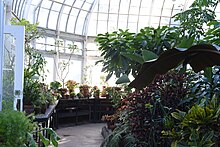

In the 17th century, botanical gardens began their contribution to a deeper scientific curiosity about plants. If a botanical garden is defined by its scientific or academic connection, then the first true botanical gardens were established with the revival of learning that occurred in the European Renaissance. These were secular gardens attached to universities and medical schools, used as resources for teaching and research. The superintendents of these gardens were often professors of botany with international reputations, a factor that probably contributed to the creation of botany as an independent discipline rather than a descriptive adjunct to medicine.[33]
Origins in the Italian Renaissance
The botanical gardens of Southern Europe were associated with university faculties of medicine and were founded in Italy at Orto botanico di Pisa (1544), Orto botanico di Padova (1545), Orto Botanico di Firenze (1545), Orto Botanico dell'Università di Pavia (1558) and Orto Botanico dell'Università di Bologna (1568).[nb 2] Here the physicians (referred to in English as apothecaries) delivered lectures on the Mediterranean "simples" or "officinals" that were being cultivated in the grounds. Student education was no doubt stimulated by the relatively recent advent of printing and the publication of the first herbals.[34] All of these botanical gardens still exist, mostly in their original locations.
Northern Europe
The tradition of these Italian gardens passed into
Beginnings of botanical science
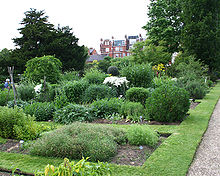

During the 16th and 17th centuries, the first plants were being imported to these major
In the mid to late 17th century, the Paris
18th century
With the increase in
The Cape, Dutch East Indies
The 18th century was marked by introductions from the Cape of South Africa – including ericas, geraniums, pelargoniums, succulents, and proteaceous plants – while the Dutch trade with the Dutch East Indies resulted in a golden era for the Leiden and Amsterdam botanical gardens and a boom in the construction of conservatories.
Royal Botanic Gardens, Kew
The Royal Gardens at Kew were founded in 1759, initially as part of the Royal Garden set aside as a physic garden.

At this time, British horticulturalists were importing many
Bartram's Garden
In 1728, John Bartram founded Bartram's Garden in Philadelphia, one of the continent's first botanical gardens. The garden is now managed as a historical site that includes a few original and many modern specimens as well as extensive archives and restored historical farm buildings.[47]
Plant classification
The large number of plants needing description were often listed in garden catalogues; and at this time
19th century
The late 18th and early 19th centuries were marked by the establishment of tropical botanical gardens as a tool of
Tropical botanical gardens
There are currently about 230 tropical botanical gardens with a concentration in southern and south-eastern Asia.

Included in the charter of these gardens was the investigation of the local
Australia
The first botanical gardens in
New Zealand
Major botanical gardens in
Hong Kong
Hong Kong Botanic Gardens, 1871 (renamed Hong Kong Zoological and Botanical Gardens in 1975), up from the Government Hill in Victoria City, Hong Kong Island.
Japan
The
Sri Lanka
In Sri Lanka major botanical gardens include the Royal Botanical Gardens, Peradeniya (formally established in 1843), Hakgala Botanical Gardens (1861) and Henarathgoda Botanical Garden (1876).
Ecuador
The botanical garden of Quito is a park, a botanical garden, an arboretum and greenhouses of 18,600 square meters that is planned to increase, maintain the plants of the country (Ecuador is among the 17 richest countries in the world in the native species, a study on this matter). The Ecuadorian flora classified, determines the existence of 17,000 species)
Egypt
The Orman Garden, one of the most famous botanical gardens in Egypt, is located at Giza, in Cairo, and dates back to 1875.
South Africa
South Africa has ten national level botanical gardens all of which are overseen by the South African National Biodiversity Institute (SANBI).[59]
The oldest botanical garden in South Africa is the Durban Botanic Gardens which has been located on the same site since 1851. The Kirstenbosch National Botanical Garden is the most famous and developed garden in the country, established in 1913 on a site dating to 1848 and covering a 36 hectare area with an additional 528 hectares of mountainside wilderness that form part of the garden.[60] Stellenbosch University Botanical Garden is the oldest university botanical garden in South Africa, and was established in 1922. Other botanical gardens in country include the Walter Sisulu National Botanical Garden, Harold Porter National Botanical Gardens and Karoo Desert National Botanical Garden. Some smaller gardens and parks that verge on being a botanical garden includes the Arderne Gardens in Cape Town founded in 1845.
United States
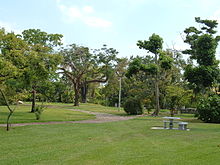
The first botanical garden in the
Russia

Russia has more gardens describing themselves as botanical gardens than any other country.[citation needed] Better-known gardens are Moscow University Botanic Garden ('the Apothecary Garden'), (1706), Saint Petersburg Botanical Garden, (1714); and Moscow Botanical Garden of Academy of Sciences, (1945).
These gardens are notable for their structures that include sculptures,
Among the smaller gardens within Russia, one that is increasingly gaining prominence, is the Botanical Garden of Tver State University (1879) – the northernmost botanical Garden with an exhibition of steppe plants, only one of its kind in the Upper Volga.
Ukraine
20th century
Civic and municipal botanical gardens
A large number of civic or municipal botanical gardens were founded in the 19th and 20th centuries. These did not develop scientific facilities or programmes, but the horticultural aspects were strong and the plants often labelled. They were botanical gardens in the sense of building up collections of plants and exchanging seeds with other gardens around the world, although their collection policies were determined by those in day-to-day charge of them. They tended to become little more than beautifully maintained parks and were, indeed, often under general parks administrations.[64]
Community engagement
The second half of the 20th century saw increasingly sophisticated educational, visitor service, and interpretation services. Botanical gardens started to cater for many interests and their displays reflected this, often including botanical exhibits on themes of
With decreasing financial support from governments, revenue-raising public entertainment increased, including music, art exhibitions, special botanical exhibitions, theatre and film, this being supplemented by the advent of "Friends" organisations and the use of volunteer guides.[65]
Plant conservation
Plant conservation and the heritage value of exceptional historic landscapes were treated with a growing sense of urgency. Specialist gardens were sometimes given a separate or adjoining site, to display native and indigenous plants.[3]
In the 1970s, gardens became focused on plant conservation. The Botanic Gardens Conservation Secretariat was established by the
Role and functions
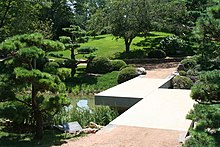
Many of the functions of botanical gardens have already been discussed in the sections above, which emphasise the scientific underpinning of botanical gardens with their focus on research, education and conservation. However, as multifaceted organisations, all sites have their own special interests. In a remarkable paper on the role of botanical gardens, Ferdinand von Mueller (1825–1896), the director of the Royal Botanic Gardens, Melbourne (1852–1873), stated, "in all cases the objects [of a botanical garden] must be mainly scientific and predominantly instructive". He then detailed many of the objectives being pursued by the world's botanical gardens in the middle of the 19th century, when European gardens were at their height. Many of these are listed below to give a sense of the scope of botanical gardens' activities at that time, and the ways in which they differed from parks or what he called "public pleasure gardens":[69]
|
|

Botanical gardens must find a compromise between the need for peace and seclusion, while at the same time satisfying the public need for information and visitor services that include restaurants, information centres and sales areas that bring with them rubbish, noise, and
Many gardens now have plant shops selling flowers, herbs, and vegetable seedlings suitable for
Future
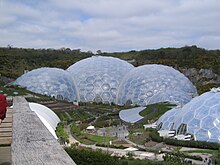
Botanical gardens are still being built, such as the first botanical garden in
Botanical gardens have always responded to the interests and values of the day. If a single function were to be chosen from the early literature on botanical gardens, it would be their scientific endeavour and, flowing from this, their instructional value. In their formative years, botanical gardens were gardens for physicians and botanists, but then they progressively became more associated with ornamental horticulture and the needs of the general public. The scientific reputation of a botanical garden is now judged by the publications coming out of herbaria and similar facilities, not by its living collections.[74] The interest in economic plants now has less relevance, and the concern with plant classification systems has all but disappeared, while a fascination with the curious, beautiful and new seems unlikely to diminish.
In recent times, the focus has been on creating an awareness of the threat to the
Photo gallery
-
University of British Columbia Botanical Garden, Canada
-
Inside the Botanical Garden of the University of Coimbra, Portugal
-
The Harry P. Leu Gardens in Orlando, Florida, US
-
The Palm House,Royal Botanic Gardens, Edinburgh, Scotland
-
Kirstenbosch National Botanical Garden, South Africa
-
Butchart Gardens, British Columbia, Canada
-
Buenos Aires Botanical Garden, Argentina
-
Antarctic Garden, Hobart Botanical Garden, Tasmania, Australia
-
Main building of theUniversity of Tartu Botanical Gardens, Estonia
-
Kahuna Garden, National botanical garden, Maui, Hawaii
Maps
Graphs are unavailable due to technical issues. There is more info on Phabricator and on MediaWiki.org. |
BGCI garden ID, Botanical gardens, Europe
See also
Footnotes
- ^ The terms botanic and botanical and garden or gardens are used more-or-less interchangeably, although the word botanic is generally reserved for the earlier, more traditional gardens.
- ^ Precisely dating the foundation of botanical gardens is often difficult because government decrees may be issued some time before land is acquired and planting begins, or existing gardens may be relocated to new sites, or previously existing gardens may be taken over and converted.
- ^ Glasshouses built to overwinter tender evergreen shrubs, known as 'greens', were called greenhouses, a name that is still used today.
References
- ^ EPIC. "Botanic Gardens and Plant Conservation". Botanic Gardens Conservation International. Retrieved 26 November 2022.
- ^ Spencer & Cross 2017, p. 56
- ^ a b c Huxley 1992, p. 375
- ^ Wyse Jackson & Sutherland 2000, p. 12
- ^ Wyse Jackson 1999, p. 27
- ^ a b Bailey & Bailey 1978, p. 173
- ^ Gratani, Loretta (15 January 2008). "Growth pattern and photosynthetic activity of different bamboo species growing in the Botanical Garden of Rome". Flora - Morphology, Distribution, Functional Ecology of Plants. 203 (1): 77–84 – via Science Direct.
- ^ a b c "The History of Botanic Gardens". BGCI.org. BGCI. Archived from the original on 26 November 2011. Retrieved 8 November 2011.
- ^ "东亚植物园". East Asia Botanic Gardens Network. Archived from the original on 23 January 2008. Retrieved 8 November 2011.
- S2CID 15572584.
- ^ a b Heywood 1987, p. 11
- ^ "International Association of Botanic Gardens (IABG)". BGCI.org. Botanic Gardens Conservation International. Retrieved 8 November 2011.
- ^ "Mission statement". BGCI.org. Botanic Gardens Conservation International. Archived from the original on 28 October 2011. Retrieved 8 November 2011.
- ^ "American Public Gardens Association". publicgardens.org. American Public Gardens Association. Retrieved 8 November 2011.
- ^ "Welcome to BGANZ". BGANZ.org.au. Botanic Gardens Australia and New Zealand Inc. 2011. Retrieved 8 November 2011.
- ^ Hill 1915, p. 210
- ^ Hill 1915, pp. 219–223
- ^ a b Hyams & MacQuitty 1969, p. 12
- ^ Dalley 1993, p. 113
- ^ Day 2010, pp. 65–78
- ^ Hill 1915, pp. 185–186
- ^ Toby Evans 2010, pp. 207–219
- ^ Guerra 1966, pp. 332–333
- ^ Hill 1915, p. 187
- ^ Taylor 2006, p. 57
- ^ Young 1987, p. 7
- ^ Thanos 2005
- ISBN 9780486274959.
- ^ Hill 1915, p. 188
- ^ Holmes 1906, pp. 49–50
- ^ Hyams & MacQuitty 1969, p. 16
- ^ Holmes 1906, p. 54
- ^ Williams 2011, p. 148
- ^ Hill 1915, pp. 190–197
- ^ Drayton 2000, p. 24
- ^ See Ogilvie 2006
- ^ See Minter 2000
- ^ Hill 1915, p. 200
- ^ Hill 1915, p. 205
- ^ Bute in Drayton 2000, p. 43
- ^ Drayton 2000, p. 46
- ^ Drayton 2000, p. xi
- ^ Drayton 2000, pp. 93–94
- ^ Hill 1915, p. 207
- ^ Drayton 2000, p. xiii
- ^ See Desmond 2007
- ^ "HALS No. PA-1, John Bartram House & Garden" (PDF). Historic American Landscapes Survey. Washington, D.C.: Library of Congress. 2004. Archived from the original (PDF) on 22 February 2014.
- ^ Heywood 1987, p. 7
- ^ a b c Heywood 1987, p. 9
- ^ Heywood 1987, p. 13
- ^ Heywood 1987, p. 8
- ^ Hill 1915, pp. 212–213
- ^ Hill 1915, p. 213
- ^ Hill 1915, p. 222
- ^ Heywood 1987, p. 10
- ^ Looker in Aitken & Looker 2002, p. 98
- ^ "Plan of Management for Auburn Botanic Gardens Precinct" (PDF). Retrieved 12 December 2012.
- ^ "Sitio Oficial Turístico de Quito – Parque La Carolina". Quito Government. Archived from the original on 27 November 2010. Retrieved 8 July 2009.
- ^ "National botanical gardens include Kirstenbosch, Harold Porter, Walter Sisulu, Pretoria, Lowveld, Free State and KwaZulu-Natal; local botanical gardens include Johannesburg and Durban (GL)". www.southafrica.net. Retrieved 7 October 2022.
- ^ "Kirstenbosch National Botanical Gardens, Cape Town | South African History Online". www.sahistory.org.za. Retrieved 7 October 2022.
- ^ a b Huxley 1992, p. 376
- ^ "Brief History of the U.S. Botanic Garden". usbg.gov. United States Botanic Garden. Retrieved 10 June 2013.
- ISBN 978-0-674-97942-0.
- ^ Heywood 1987, pp. 10–16
- ^ Looker in Aitken & Looker 2002, pp. 99–100
- ^ See Simmons et al. 1976
- ^ Huxley 1992, p. 377
- ^ "North American Botanic Garden Strategy for Plant Conservation" (PDF). Botanic Gardens Conservation International. 2006.
- ^ Mueller 1871
- Royal Botanic Gardens Melbourne. 8 June 2010. Archived from the originalon 31 July 2010. Retrieved 6 August 2010.
- ^ "Hainan Botanical Garden of Tropical Economic Plants". BGCI.org. Botanic Gardens Conservation International. Retrieved 8 November 2011.
- ^ Heywood 1987, p. 12
- ISSN 0020-2754.
- ^ Heywood 1987, p. 16
- ^ Drayton 2000, pp. 269–274
Bibliography
- Aitken, Richard & Looker, Michael (2002). The Oxford Companion to Australian Gardens. Melbourne: Oxford University Press. ISBN 978-0-19-553644-7.
- Bailey, Liberty Hyde & Bailey, Ethel Z. (1978). Hortus Third. New York: Macmillan. ISBN 978-0-02-505470-7.
- Conan, Michel, ed. (2005). Baroque garden cultures: emulation, sublimation, subversion. Washington, D.C.: Dumbarton Oaks Research Library and Collection. ISBN 9780884023043. Retrieved 21 February 2015.
- Johnson, Dale E (1985). "Literature on the history of botany and botanic gardens 1730–1840: A bibliography". PMID 11620777.
- JSTOR 1587050.
- Day, Jo (2010). "Plants, Prayers, and Power: the story of the first Mediterranean gardens". In O’Brien, Dan (ed.). Gardening Philosophy for Everyone. Chichester: Wiley-Blackwell. pp. 65–78. ISBN 978-1-4443-3021-2.
- Desmond, Ray (2007). The History of the Royal Botanic Gardens Kew. London: Kew Publishing. ISBN 978-1-84246-168-6.
- Drayton, Richard (2000). Nature's Government: Science, Imperial Britain, and the 'Improvement' of the World. London: Yale University Press. ISBN 978-0-300-05976-2.
- Guerra, Francisco (1966). "Aztec Medicine". Medical History. 10 (4): 315–338. PMID 5331692.
- Heywood, Vernon H. (1987). "The changing rôle of the botanic gardens". In Bramwell, David; et al. (eds.). Botanic Gardens and the World Conservation Strategy. London: Academic Press. pp. 3–18. ISBN 978-0-12-125462-9.
- Heutte, Fred (1872). "A New Concept: the Commercial Botanical Garden". American Horticulturalist. 51 (2): 14–17.
- JSTOR 2990033.
- Holmes, Edward M. (1906). "Horticulture in Relation to Medicine". Journal of the Royal Horticultural Society. 31: 42–61.
- Huxley, Anthony (ed. in chief) (1992). The New Royal Horticultural Society Dictionary of Gardening. London: Macmillan. ISBN 978-1-56159-001-8.
- Hyams, Edward & MacQuitty, William (1969). Great Botanical Gardens of the World. London: Bloomsbury Books. ISBN 978-0-906223-73-4.
- Klemun, Marianne, The Botanical Garden, EGO - European History Online, Mainz: Institute of European History, 2019, retrieved: March 8, 2021 (pdf).
- MacDougal, D. T. (1920). . Encyclopedia Americana.
- Monem, Nadine K., ed. (2007). Botanic Gardens: A Living History. London: Black Dog. ISBN 978-1-904772-72-9.
- Minter, Sue (2000). The Apothecaries' Garden. Stroud, UK: Sutton Publishing. ISBN 978-0-7509-2449-8.
- Mueller, Ferdinand von (1871). The objects of a botanic garden in relation to industries : a lecture delivered at the Industrial and Technological Museum. Melbourne: Mason, Firth & McCutcheon.
- Ogilvie, Brian W. (2006). The Science of Describing: Natural History in Renaissance Europe. Chicago: University of Chicago Press. ISBN 978-0-226-62087-9.
- Rakow, Donald; Lee, Sharon, eds. (2013). Public garden management. Hoboken, N.J.: Wiley. ISBN 9780470904596. Retrieved 21 February 2015.
- Simmons, J.B.; Beyer, R.I.; Brandham, P.E.; Lucas, G. Ll.; Parry, V.T.H., eds. (1976). Conservation of Threatened Plants. London: Plenum Press. ISBN 978-0-306-32801-5.
- S2CID 251005623.
- Taylor, Patrick (2006). The Oxford Companion to the Garden. Oxford: Oxford University Press. ISBN 978-0-19-866255-6.
- Thanos, C.A. (2005). "The Geography of Theophrastus' Life and of his Botanical Writings (Περι Φυτων)". In Karamanos, A.J.; Thanos, C.A. (eds.). Biodiversity and Natural Heritage in the Aegean, Proceedings of the Conference 'Theophrastus 2000' (Eressos – Sigri, Lesbos, 6–8 July 2000). Athens: Fragoudis. pp. 23–45. Retrieved 30 November 2011.
- Toby Evans, Susan (2010). "The Garden of the Aztec Philosopher-King". In O'Brien, Dan (ed.). Gardening Philosophy for Everyone. Chichester: Wiley-Blackwell. pp. 207–219. ISBN 978-1-4443-3021-2.
- Williams, Roger L. (2011). "On the establishment of the principal gardens of botany: A bibliographical essay by Jean-Phillipe-Francois Deleuze". Huntia. 14 (2): 147–176.
- Wyse Jackson, Peter S. & Sutherland, Lucy A. (2000). International Agenda for Botanic Gardens in Conservation (PDF). Richmond, UK: Botanic Gardens Conservation International. Archived from the original (PDF) on 27 March 2009. Retrieved 30 November 2009.
- Wyse Jackson, Peter S. (1999). "Experimentation on a Large Scale – An Analysis of the Holdings and Resources of Botanic Gardens". BGCNews. 3 (3): 53–72. Archived from the original on 17 April 2009.
- Young, Michael (1987). Collins Guide to the Botanical Gardens of Britain. London: Collins. ISBN 978-0-00-218213-3.










